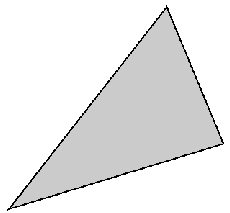This bound is asymptotically reached for the Bernouilli distribution when its parameter tends to 0 or to 1 [5].
When d=2, the upper bound of the chiral index is shown [7] to lie in the interval [1-1/π;1-1/2π].
The bound 1-1/π is conjectured to be optimal and it is asymptotically reached for a rather awkward family of bivariate distributions [7].
The most chiral triangle, i.e. the most chiral three points set, is known [8]: see Fig. 1.
For d=3, the most chiral tetrahedron, i.e. the most chiral four points set, is unknown.
However the most chiral disphenoid (or isosceles tetrahedron, or equifacial tetrahedron), is known [9].
Its chiral index and its triangular face are given in Fig. 2.
For any d value, the upper bound of the chiral index is shown [10] to lie in the interval [1/2;1].
The upper bound of the chiral index of a d-variate distribution remains unknown when d>1.
A summary of several known extreme distributions ia available in [11].
|
|


